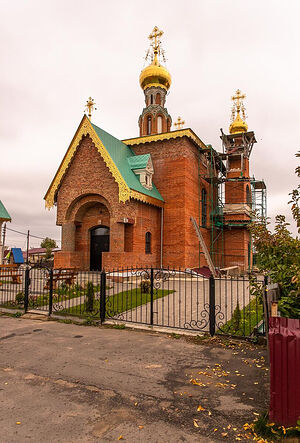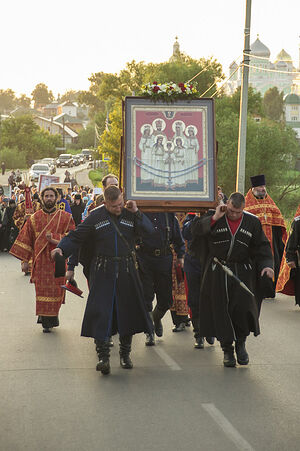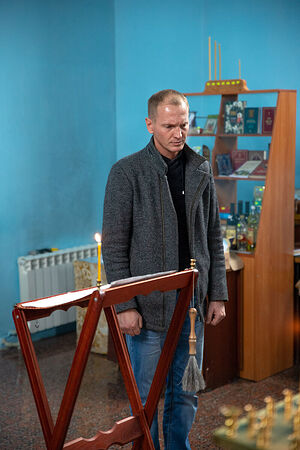“TO ENSURE THAT THE LITURGY BE CELEBRATED IN THE LAND OF MY ANCESTORS”
On how a former detective and prisoner became a church warden
 The Church of the Holy Royal Martyrs in DiveyevoThe Church of the Holy Royal Martyrs appeared in Diveyevo quite recently—its foundation was laid in 2015, and the first Liturgy was celebrated in 2019. There is an old Russian saying, “A church is not about logs, but about ribs”. Indeed, over and over again you become convinced that the history of every church is closely linked with someone’s life.
The Church of the Holy Royal Martyrs in DiveyevoThe Church of the Holy Royal Martyrs appeared in Diveyevo quite recently—its foundation was laid in 2015, and the first Liturgy was celebrated in 2019. There is an old Russian saying, “A church is not about logs, but about ribs”. Indeed, over and over again you become convinced that the history of every church is closely linked with someone’s life.
The birth of a church is no less a miracle than the birth of a new human soul into the world. Many Lives of saints begin with a story about the miraculous birth of a saint or even earlier: with a story about how the parents of a future God-pleaser prepared for his or her birth, prayed to God for a child, made vows and humbly awaited an answer from above.
All this can be found in the history of the “Royal” church in Diveyevo. The devotees of the last Russian Tsar and his family have been praying for many years for the building to be completed. They sang akathists by the memorable larch tree planted in honor of the birth of the heir, Tsarevich Alexei, offered up prayers on the Holy Canal, and read the perpetual Psalter.
 The cross procession in the early morning of July 17, 2015 to the foundation of the Church of the Royal MartyrsFinally, in 2015, a benefactor was found who bought a plot of land at the intersection of Polevaya and Zarechnaya Streets for the construction of a church. On the day of the celebration of the Synaxis of the Saints of Diveyevo, June 27, 2015, a memorial cross was installed and blessed at the future construction site. And at dawn on July 17, on the day and hour of the murder of the Royal Martyrs, Metropolitan George of Nizhny Novgorod and Arzamas laid the foundation stone and blessed the foundation of the new church. It was built in just two weeks. Right before the arrival of the procession presided over by the bishop, a crane drove off from the construction site, having laid the last slabs.
The cross procession in the early morning of July 17, 2015 to the foundation of the Church of the Royal MartyrsFinally, in 2015, a benefactor was found who bought a plot of land at the intersection of Polevaya and Zarechnaya Streets for the construction of a church. On the day of the celebration of the Synaxis of the Saints of Diveyevo, June 27, 2015, a memorial cross was installed and blessed at the future construction site. And at dawn on July 17, on the day and hour of the murder of the Royal Martyrs, Metropolitan George of Nizhny Novgorod and Arzamas laid the foundation stone and blessed the foundation of the new church. It was built in just two weeks. Right before the arrival of the procession presided over by the bishop, a crane drove off from the construction site, having laid the last slabs.
A memorable moment was when the hierarch’s Protodeacon Andrei Zheleznyakov after the blessing unexpectedly sang everyone the song: “Rus’ is Called Holy...” His wonderful baritone, amplified by sound equipment, carried the words of this amazing song over the sleepy village. It seems that then I heard it for the first time, and maybe for the first time I felt it so closely that it gave me goosebumps. At sunrise on the day of the anniversary of the Tsar’s martyrdom, at the laying of his church’s foundation, among the people frozen in dead silence, it sounded like true repentance.
The new church in Diveyevo was modelled on the Church of St. Mary Magdalene in the German town of Darmstadt, built on St. Nicholas II’s initiative at the Imperial Family’s personal expense, according to the design of the architect Leonty Nikolaevich Benois (1856–1928) from St. Petersburg. In Germany the church literally stands on Russian soil—it was specially brought there in carriages—two from each Russian province. Its Diveyevo counterpart also stands on an artificial mound, with the sole difference that it was not necessary to go so far for soil; it is local, Russian and holy—from the Fourth Garden of the Most Holy Theotokos. And it is covered with paving stones from the Canal of the Queen of Heaven.
 The churchwarden Alexei, a former detectiveThe visitor sees a majestic mosaic that fills the interior of the altar apse—the Mother of God on the throne, a copy from the original mosaic at the Darmstadt church according to a sketch by the artist Viktor Vasnetsov (1848–1926). The icons on the iconostasis were copied from the originals as well. All the church icons are unique, and most of them are with particles of relics.
The churchwarden Alexei, a former detectiveThe visitor sees a majestic mosaic that fills the interior of the altar apse—the Mother of God on the throne, a copy from the original mosaic at the Darmstadt church according to a sketch by the artist Viktor Vasnetsov (1848–1926). The icons on the iconostasis were copied from the originals as well. All the church icons are unique, and most of them are with particles of relics.
Every weekday at noon the akathist to the Holy Royal Martyrs is sung here. It is sponsored by the churchwarden, Alexei Butusov, a man with an extraordinary life—he was formerly police officer who spent many years as a forensics investigator, was unjustly convicted and spent time in various prisons, from which he returned as a sincerely religious man. Alexei was a prison church warden. Now he carries out his duties here—in a new church, which has by the will of God appeared in his native village.
“Previously, this place belonged to the village of Vertyanovo, which in the 1960s merged with Diveyevo. There had never been a church in it. But there was a prophecy of St. Seraphim of Sarov that Vertyanovo would have its own church and that it would become a town. We can say that now Vertyanovo has received village status, and we are witnessing the fulfillment of these prophecies. Diveyevo has long been holiness, and Vertyanovo is the opposite. As a child I heard many stories from old people that there were many sorcerers and witches here, along with bandits and robbers. This area was especially criminal. Up to our day, blood has been spilled here—in 1996 my godfather Valery was killed at this intersection. I don’t rule out that this church has providentially appeared here for the sanctification of the area, like those ancient churches that were built on the sites of pagan temples. Here, on the present territory of the church, Schemanun Barbara lived in a tiny bathhouse. Wasn’t she the one who sanctified this place by her prayers?”
 Inside, the church is rather smallInside, the church is rather small—it can accommodate about fifty to seventy people. But the significance of the new church for Diveyevo seems enormous. The last Russian Emperor, St. Nicholas II, is closely connected with Diveyevo and the Venerable Seraphim of Sarov. After all, it was he who signed the decree on the canonization of St. Seraphim, and he headed the celebrations of 1903. Therefore, the monarch and his family are especially revered in Diveyevo. I asked Alexei how fate connected him with the Romanovs and this church.
Inside, the church is rather smallInside, the church is rather small—it can accommodate about fifty to seventy people. But the significance of the new church for Diveyevo seems enormous. The last Russian Emperor, St. Nicholas II, is closely connected with Diveyevo and the Venerable Seraphim of Sarov. After all, it was he who signed the decree on the canonization of St. Seraphim, and he headed the celebrations of 1903. Therefore, the monarch and his family are especially revered in Diveyevo. I asked Alexei how fate connected him with the Romanovs and this church.
“Our family comes from Vertyanovo. All my ancestors lived here, and it is still home to many of my relatives. Many of them were chairmen, managers, policemen... According to tradition, our family descends from the Cossacks whom Tsar Ivan the Terrible settled here during his Kazan Campaign to preserve Orthodoxy in this area. While I was still in the penal colony, I once had a dream that I was walking through Diveyevo, and when I approached the place where the church now stands I saw many people praying here, and a pillar of light rising to heaven. When I returned, I met General Ivan Mikhailovich Shein, the benefactor of this church, and, having received the blessing of the head of the deanery, I began to read the akathist here. There was a concrete floor here, the windows were covered with plastic, and there was scaffolding. The construction didn’t move forward then—there were no funds. I lived in my parents’ apartment nearby. I would get up early and come here to read the akathist. There were many supernatural events that are difficult for inexperienced people to fathom. On the third day, when I went outside after the akathist, it was still dark and there was a strong smell of scorched brambles around the church. Even when I got home, my mother smelled it. And sometimes I came after the akathist completely exhausted, fell into bed and slept all day long. This is what happens after someone possessed has been exorcised. But I had a goal: to ensure that the Liturgy be celebrated here, on the land of my ancestors. When I converted to the faith through all these sorrows, the Lord revealed to me that everything in our world revolves around the Liturgy—it is the crown of everything. Only through the Bloodless Sacrifice will we be transformed. And the Royal Martyrs are family saints! To whom if not to them should we pray to for marriage and the preservation of a family, for the peace and prosperity of our land?”
In the service of reading the akathist Alexei has included a song he heard in places of confinement: the penetrating Serbian chant, “Faith Eternal, Glorious Faith, Our Faith is Orthodox.” When it resounded under the echoing vaults of the church, performed by pleasant male voices (Alexei’s second cousin Vasily has recently begun singing along with him), I involuntarily recalled that unexpected singing by Protodeacon Andrei at the laying of the church’s foundation. The churchwarden admitted that he had learned this song by heart in prison using the recording by Zheleznyakov, which had come in a parcel. For Alexei, prison became a “theological academy” where he not only studied the Orthodox faith, but also mastered the duties of a reader, an acolyte, and a chanter in practice.
“One priest there revealed to me why all these sorrows had befallen me. He said: ‘The Lord is giving you a “gift”, so that you will pray for your whole family.’ And I pray for all my relatives—both the departed and the living. Not everyone understands me. Some give the screw loose sign, saying that I’ve gone crackers, etc. When I came here, they said to me: ‘What do you need this for? Give it all up—find a wife, buy a car, earn money...’ They think about worldly blessings without understanding the significance of this church in our land. A benefactress said these words to me: ‘Alexei, I have built more than one church, and I know that churches are built by everyone together!’ Therefore, the involvement of each person is important—some help with money, others with physical work, others with prayer. Everyone participates in the construction. And the Holy Royal Martyrs intercede for them with the Lord.”
10/27/2021


No hay comentarios:
Publicar un comentario